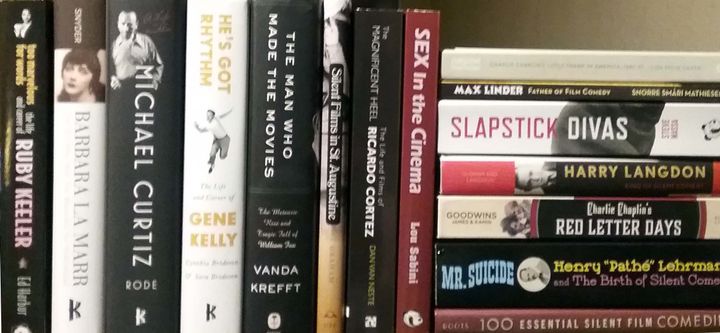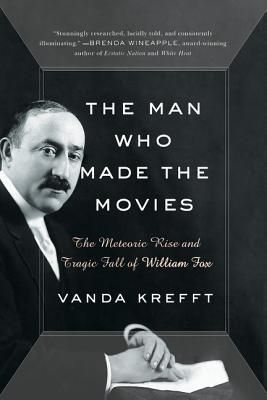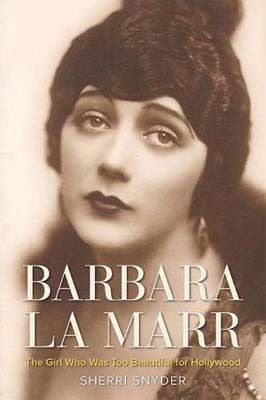
Some of the many film books published this year
The better film books, in particular the best biographies and histories, are those works which break new ground, or illuminate some previously little seen aspect of the cinema. This year saw the release of at least five books which do just that—four of them are biographies of important figures which till now have received scant, or insufficient, recognition. (That’s a relative claim, of course.) The other is an exceptional group study which reveals a host of undervalued performers. For movie lovers who like to read up on film history, each of these titles is worth adding to your shelves.
This list of recommended film books compares with last year’s, which was also bountiful and demanded a second take. As a matter of fact, there were so many worthwhile books this year that I am considering a second shortlist, something along the lines of “Best Film Books of 2017: Silent Comedy Edition.” Until then…. Check out these highly recommended titles.
The Man Who Made the Movies: The Meteoric Rise and Tragic Fall of William Fox (Harper) by Vanda Krefft
Although a Hollywood studio still bears his name, William Fox has largely been forgotten. Entertainment journalist Vanda Krefft sets the record straight, and in doing so, shows why Fox’s legacy is central to the history of the motion picture and entertainment industries. Like Thomas Edison (with whom he did battle) and Walt Disney and Steve Jobs, Fox was a captain of industry. His improbable rags-to-riches story is told in grand style, but spoiler alert, it’s not a happy ending. Fox would lose it all. At nearly a thousand pages, Krefft’s thoroughly researched, engagingly written book shows this scrappy visionary to be an enabler of the best sort of talent. We have Fox to thank for vamp Theda Bara, cowboy star Tom Mix, directors John Ford and Howard Hawks, F.W. Murnau’s Sunrise, and so much more. (For more on Fox’s legacy, see Twentieth Century Fox: A Century of Entertainment below.)

The Man Who Made the Movies: The Meteoric Rise and Tragic Fall of William Fox by Vanda Krefft
Michael Curtiz: A Life in Film (University Press of Kentucky) by Alan K. Rode
In this first biography of the Academy Award–winning director Michael Curtiz (1886–1962), film scholar Alan K. Rode takes us through the colorful and sometimes temperamental personal life and magisterial films of a multifaceted overachiever. During his remarkable twenty-seven year tenure at Warner Brothers, Curtiz directed swashbuckling adventures, westerns, war films, gangster films, musicals, historical dramas, horror films, tearjerkers, melodramas, comedies, and even a film noir masterpiece. The director's staggering output of 180 films surpasses that of John Ford, and exceeds the combined total of films by George Cukor, Howard Hawks, and Victor Fleming! And it wasn’t just quantity—there was quality, aplenty. Curtiz’s best-known efforts include such classics as The Adventures of Robin Hood (1938), Casablanca (1942), Yankee Doodle Dandy (1942), Mildred Pierce (1945) and White Christmas (1954). I love Captain Blood (1935), Passage to Marseille (1944), and Young Man with a Horn (1950), and have a not-so-secret weakness for one of his lesser films, God’s Gift to Women (1931). On top of all that, the Hungarian-born Curtiz (who worked in Europe before coming to America) co-wrote the screenplay for the first known Dracula film, Drakula Halala (1921)! As Rode shows in this impressive book, Curtiz did it all; Rode has written the definitive biography of a major figure in Hollywood history.

Michael Curtiz: A Life in Film by Alan K. Rode
Slapstick Divas: The Women of Silent Comedy (BearManor Media) by Steve Massa
This book looks at the careers of the funny ladies of early film—who, compared to their male colleagues, haven’t really received the attention they deserve. Besides the better known Mabel Normand, Marie Dressler, or Marion Davies, Massa’s book looks at the careers of Louise Fazenda, Madge Kennedy, Dorothy Devore, Dot Farley, Baby Peggy and numerous other “droll divas.” It includes hundreds of rare illustrations, as well as capsule biographies of once famous, now little remembered or wholly forgotten screen comediennes. Steve Massa has written a highly recommended book which belongs on the shelves of anyone interested in early film comedy or women’s film history. Oh, and that’s Alice Howell on the book’s terrific cover; she was described as “the scream of the screen.”

Slapstick Divas: The Women of Silent Comedy by Steve Massa
Barbara La Marr: The Girl Who Was Too Beautiful for Hollywood (University Press of Kentucky) by Sherri Snyder
It’s unusual, but not unprecedented for an actor to write a book about another actor. Simon Callow’s epic life of Orson Welles comes to mind, as does Diana Serra Carey’s (Baby Peggy’s) book on Jackie Coogan. Sherri Snyder is a Los Angeles actress who portrays Barbara La Marr in a one-woman performance piece. Having researched her subject, she found the once famous silent film star was far more than just the “girl who was too beautiful” (as she was often described). La Marr was a multitalented woman tortured by adversity who compensated for her troubles in all the wrong ways, especially through drinking and serial relationships. “I take lovers like roses” La Marr once said, “by the dozen.” Few stars have burned as brightly and as briefly as La Marr. With the help of her only child, and drawing on never-before-released documents, Snyder has penned a compelling portrait of a forgotten star.

Barbara La Marr: The Girl Who Was Too Beautiful for Hollywood by Sherri Snyder
The Magnificent Heel: The Life and Films of Ricardo Cortez (BearManor Media) by Dan Van Neste
Ricardo Cortez (1900-1977) was a leading man and later character actor with bedroom eyes and an easy smile. Widely publicized as a “Latin lover” during his rise to fame in the 1920s, Cortez was actually Jacob Krantz, a poor Jewish kid who started out as an amateur boxer and businessman. He enjoyed a long Hollywood career, appearing in Torrent (1926) opposite Greta Garbo in her first American film, a couple of Lon Chaney films, and other notable works directed by the likes of D. W. Griffith and Cecil B. DeMille. When the talkies came, Cortez transitioned successfully. He was Sam Spade in the first film adaptation of Dashiell Hammett’s The Maltese Falcon (1931)—it was just shown on TCM, and would play opposite leading ladies Joan Crawford, Barbara Stanwyck, Claudette Colbert, and Bette Davis. With the passing years, Cortez settled into character roles in films like The Case of the Black Cat (1936, as Perry Mason), Charlie Chan in Reno (1939), and Mr. Moto's Last Warning (1939). His last film was John Ford’s The Last Hurrah (1958). Cortez, who was once married to actress Alma Rubens (1897-1931), was proclaimed cinema’s “magnificent heel.” Find out why in this new book.

The Magnificent Heel: The Life and Films of Ricardo Cortez by Dan Van Neste
Regrettably, I am happy to report that there are even more worthwhile biographies and works of film history than can’t be fully recounted in this article. Nevertheless, here are a few more books readers and film buffs will want to know about.
Sex In the Cinema: The Pre-Code Years (1929-1934) (BearManor Media) by Lou Sabini & Hollywood's Pre-Code Horrors 1931-1934 (BearManor Media) by Raymond Valinoti Jr.
As the Christian right tries to push the country back to a time which never really existed, it’s worth noting that the movies of their parent’s and grandparent’s time were nearly as lurid as movies today. These two titles shine a spotlight on the Pre-code era, when gangster films, horror films, and social problem films depicted violence, drugs and sex with an honesty and flair which led to censorship (the censors were trying to return America to a time which never really existed). Among the many films under consideration in these two worthwhile books are Baby Face (1933), I Am a Fugitive from a Chain Gang (1932), and Call Her Savage (1932), as well as Freaks (1932), Frankenstein (1931), and Dracula (1931).
Twentieth Century Fox: A Century of Entertainment (Lyons Press) by Michael Troyan, Jeffrey Paul Thompson, and Stephen X. Sylvester & Paramount: City of Dreams (Taylor Trade Publishing) by Steven Bingen, with Marc Wanamaker
These two studio histories impress. Each book is oversized, detailed, and each is filled with hundreds of seldom seen or never before published images. Both take readers behind the scenes of these two important studios, past the studio gates and onto their historic sound stages, prop rooms, outdoor sets, and backlots. Have a favorite star or film associated with either Fox or Paramount? Chances are you will find something you’ve never seen before in one of these recommended new books.
Too Marvelous for Words: The Life and Career of Ruby Keeler (BearManor Media) by Ed Harbur & He's Got Rhythm: The Life and Career of Gene Kelly (University Press of Kentucky ) by Cynthia Brideson and Sara Brideson
Both of these entertainers were too marvelous for words, and both were among the most beloved of their time. Keeler (who was once married to Al Jolson) was a star of the stage and screen famous for her on-screen coupling with Dick Powell in a string of successful early musicals at Warner Brothers, particularly 42nd Street (1933). Kelly was a dancer, choreographer and actor whose memorable films include Anchors Aweigh (1945), On the Town (1949), An American in Paris (1951), and Singin' in the Rain (1952). More than half a century later, each is still a tonic for trying times.
Anne Bancroft: A Life (University Press of Kentucky) by Douglass K. Daniel & Ava Gardner: A Life in Movies (Running Press) by Kendra Bean and Anthony Uzarowski
Anne Bancroft, an Oscar and two-time Tony and Emmy award winner is not as well remembered as she should be. The role of Helen Keller's devoted teacher in The Miracle Worker (1962) earned her an Academy Award. But, it was her role as Mrs. Robinson in The Graduate (1967) that made her an icon. Bancroft’s story is told with aplomb in Daniel’s new book. Renowned for her screen performances, down-to-earth personality, and love affair with Frank Sinatra, Ava Gardner also left an indelible mark on Hollywood history. Her adventurous life story is told through hundreds of photos in this attractive, and enjoyable new book.
Silent Films in St. Augustine (University Press of Florida) by Thomas Graham & Asheville Movies Volume 1: The Silent Era (Men With Wings Press) by Frank Thompson
Before Hollywood, when America's emerging motion picture industry was largely based on the East Coast, early film stars like Rudolph Valentino, Ethel Barrymore, Oliver Hardy and Thomas Meighan made movies in places like St. Augustine, Florida and Asheville, North Carolina. These two books tells the story of the producers, directors, actors and crews who—in search of new locales—escaped New York winters to make movies in the sunny South. This is local film history writ large.
And without going into detail, here are yet a few more interesting, fun and worthwhile books film buffs will want to check out: We'll Always Have Casablanca: The Life, Legend, and Afterlife of Hollywood's Most Beloved Movie (W. W. Norton & Company) by Noah Isenberg; Pandora’s Box by Pamela Hutchinson (BFI Film Classics); Warner Bros: The Making of an American Movie Studio (Yale University Press) by the inestimable David Thomson; Hank and Jim: The Fifty-Year Friendship of Henry Fonda and James Stewart (Simon & Schuster) by the equally inestimable Scott Eyman; Hollywood at Play: The Lives of the Stars Between Takes (Lyons Press) by Stephen X. Sylvester, Mary Mallory, & Donovan Brandt; and not one, but two books on the most vivacious star of the 1930’s, Carole Lombard: Twentieth-Century Star (The History Press) by Michelle Morgan, and Screwball: The Life of Carole Lombard (Echo Point Books & Media) by Larry Swindell. And hot off the press is a new edition of Leonard Maltin's Movie Guide: The Modern Era.
Thomas Gladysz has been writing about early film for more than 20 years. His work has appeared in PopMatters, Classic Images, and the San Francisco Chronicle, and in programs for Telluride, Syracuse Cinefest, Ebertfest, and the San Francisco Silent Film Festival. He is also the author of three books on the films of Louise Brooks, including most recently, Now We’re in the Air, and Beggars of Life: A Companion to the 1928 Film.
